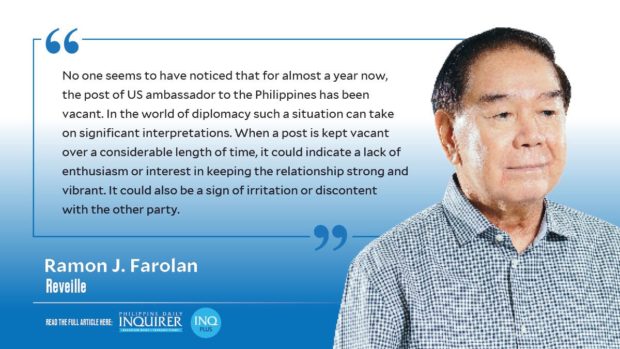Missing ambassador
 Recently a number of activities took place marking the 70th anniversary of the Mutual Defense Treaty between the Philippines and the United States. High dignitaries from the defense and state departments of both countries gathered in Washington to celebrate the occasion. But amidst calls for greater cooperation and strengthening of the alliance to include a review of the aging agreement, no one seems to have noticed that for almost a year now, the post of US ambassador to the Philippines has been vacant. In the world of diplomacy such a situation can take on significant interpretations. When a post is kept vacant over a considerable length of time, it could indicate a lack of enthusiasm or interest in keeping the relationship strong and vibrant. It could also be a sign of irritation or discontent with the other party.
Recently a number of activities took place marking the 70th anniversary of the Mutual Defense Treaty between the Philippines and the United States. High dignitaries from the defense and state departments of both countries gathered in Washington to celebrate the occasion. But amidst calls for greater cooperation and strengthening of the alliance to include a review of the aging agreement, no one seems to have noticed that for almost a year now, the post of US ambassador to the Philippines has been vacant. In the world of diplomacy such a situation can take on significant interpretations. When a post is kept vacant over a considerable length of time, it could indicate a lack of enthusiasm or interest in keeping the relationship strong and vibrant. It could also be a sign of irritation or discontent with the other party.
When ambassadors are abruptly withdrawn or recalled, a more serious situation exists. This is true in the case involving France, Australia, and the United States. The cancellation by Australia of a multibillion dollar diesel-powered submarine deal with France, for nuclear-powered subs offered by the United States, resulted in France withdrawing its envoys from Canberra and Washington, DC, and calling their actions “a stab in the back” and a betrayal of trust among allies.
In the case of Philippine-US diplomatic relations, when Ambassador Thomas Hubbard left in July 2000 it was one year and seven months before his successor Ambassador Francis Ricciardone Jr. arrived in February 2002. In the interim, a charge d’affaires headed the embassy.
Bits of historyThe first US ambassador Paul V. McNutt was actually the US high commissioner to the Philippine Commonwealth government. His title simply changed from high commissioner to ambassador. McNutt was a former governor of Indiana, with the reputation of an old-style machine politician who required state employees to donate two percent of their salaries to the Indiana Democratic Party. In 1936, President Franklin Delano Roosevelt appointed him high commissioner for his support in FDR’s re-election bid. He was succeeded by Emmet O’Neal, a discarded Kentucky politician who served for a brief period before returning to his law practice.
In 1952, Admiral Raymond Spruance, the hero of “The Battle of Midway,” was appointed by President Harry Truman to serve in Manila. Spruance, a graduate of the US Naval Academy, is regarded as one of the greatest admirals of the US Navy. He led the attack at Midway that wiped out Japan’s carrier fleet and turned the tide in the Pacific War. His stint in the Philippines saw the election of Ramon Magsaysay to the presidency.
Charles “Chip” Bohlen was a foreign policy adviser to every US President from 1943 to 1968. His expertise was on Europe, particularly the Soviet Union where he served as ambassador. But he had problems with Secretary of State John Foster Dulles who exiled him to the Philippines from 1957 to 1959. He replaced Ambassador Albert Nufer who died of coronary thrombosis at his residence in 1956, the sole envoy to die in Manila.
Gen. Henry A. Byroade graduated from the US Military Academy at West Point, joining the Corps of Engineers of the US Army. President Richard Nixon appointed him ambassador to the Philippines in 1969 and it was during his tour of duty that President Ferdinand Marcos declared martial law in September 1972. During the martial law years that followed, William Sullivan, Richard Murphy, Michael Armacost, and Stephen Bosworth, all seasoned career diplomats, took turns at the Manila embassy with Bosworth overseeing the departure of Marcos after Edsa.
The first female US ambassador to Manila was Kristie Kenney who served from March 2006 to July 2009. She was followed by the first African-American envoy to the Philippines, Harry K. Thomas Jr., who got embroiled in a controversy over his remark that “40 percent of male tourists to the Philippines go there for sex.” He apologized and ended his tour of duty with a second wife, a Filipino. The first Asian-American and the last to serve in Manila was Sung Y. Kim, a Korean-American who left in October 2020.
Perhaps Uncle Sam does not really need an ambassador in Manila. His connections in our government are impeccable and highly reliable. In 2016, President Duterte declared an end to RP-US military exercises. “Balikatan” continues to this day. The President called for the termination of the Visiting Forces Agreement. The VFA continues aided by US vaccine diplomacy.















